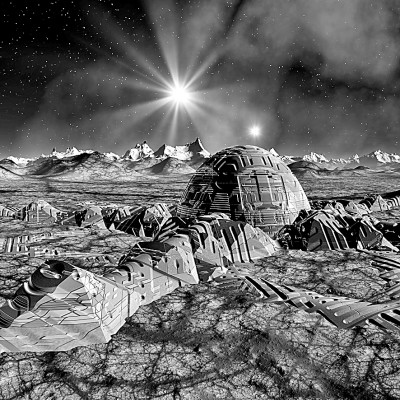Looking for Earth 2.0
Author:Guangming Daily client Time:2022.09.15

Guangming Picture/Vision China

Guangming Picture/Vision China

Guangming Picture/Vision China

Guangming Picture/Vision China

Guangming Picture/Vision China
There are water on the moon and high content of water -recently, Chinese scientists have new discoveries on the research of the moon soil that "unlock" the infinite possibilities of the moon -can you grow vegetables? Can you pour flowers? Can you drink it? This discovery successfully evokes everyone's interest in moving out of the planet. In fact, in the past 30 years, scientists have never stopped looking for livable planets, and the number of planets outside the solar system that has been explored currently has exceeded 5,000. Among these exterior planets, there are hotup -star groups with mysteries, and there are also candidates for livable planets that have been expected. Is the earth 2.0 carried out of the earth's civilization?
1 Search for the second solar system
"At the beginning of the ancient times, who preached? The upper and lower are not forming, why is it? Ming Zhao is dark, who can be extremely? In this "Sky Question", he explained the thinking about the heaven and earth Xuanhuang and the flood of the universe, and he even boldly guess the world outside the world. Today, more than 2000 years later, we are still discussing that the solar system of life and civilization has a unique existence in the vast universe?
It is estimated that in the considerable universe, the galaxy including the galaxy is as high as 100 billion yuan, and the main star that humans live in -the sun, the sun, is just a one of the 100 billion stars in the galaxy. Because of this, it is difficult for us to believe that except for the small solar system in the universe, no other star system can bred the planet and carry life.
However, due to the observation technology, for a long time, our awareness of the universe is indeed the same -the solar system of eight major planets including the earth, which is known by humans. Essence
Such cognition was changed in 1992. This year, astronomers Waldissen and Freyo founded land -like planets outside the solar system for the first time. But the main star they around is just the wreckage of a star -the millisecond pulse star PSRB1257+12, its rotation speed is as high as 161 times per second, which is obviously far from the second solar system in human ideals.
Fortunately, three years later, the two Swiss astronomers Mario and Queliz, which is very similar to the heart, is the main preface of the primitive Star Flying Malaysia 51, and found the first size comparable to Jupiter's gesture. The giant planet, it is named as 51B of Pegasus, about 50 light years from the earth.
This discovery ignited the enthusiasm of searching for the second solar system in the astronomy community. Since then, the detection of external planet officially kicked off.
However, as the first planet that surrounds the solar star discovered by humans, Pegasus 51B is very different from the eight planets in the solar system. Although its quality and size are equivalent to Jupiter, its revolution cycle is only about 4 days. It is not only different from Jupiter for about 12 years of bypassing cycles, but also far less than the revolution cycle of any planet in the solar system.
In fact, in the early stage of the planet detection, a short -cycle giant star like Pegasus 51B appeared frequently. Astronomers collectively refer to them Jupiter. The number of hot Jupiter has made astronomers doubt that in the universe, the mysterious Jupiter is the mainstream of the planet, and the warm and cold stars in the solar system are just a special case in the planetary group.
However, after understanding the basic means of planet detection, this question was solved.
2 It has been found to be over 5,000 solar systems outer planets
The most intuitive way to explore the planet outside the solar system is to observe directly. But as we all know, the planets themselves are not glowing. What we see is that they reflect the light from the stars. Therefore, during direct observation, the faint reflex light of the planet will be obliterated in the dazzling light of its main star, which is difficult to distinguish. Theoretically, even if the daily corona can cover the brightness of the main star and highlight the existence of the planet, it is very difficult to implement the technical difficulty, only applicable to the planet groups that are far from the influence of the main star.
Compared with direct imaging, indirect detection is more common, which is an important way to search for planets. Among them, the most efficient external planet detection method is Lingxing method. According to statistics, about 70%of the planets were found in this method.
Ling Xingfa, using the planet to revolt around the main star, will periodically cover the principle of the light of the main star. Monitor the periodic changes of the lightness of the main star, and according to the depth, cycle, and width of the light, it can be speculated that the relative size and rail information of the unknown planet can be speculated. Generally, when the big planet surrounds the small main star, the shading area is large, and the light changes are obvious. Taking the solar system as an example, Jupiter's light changes depth of the light of the day are about 1%, while the depth of the light of the earth is only 0.0084%.
There is also a common planet detection method, which is the video speed method -when the planet rotates around the main star, the main star will also rotate the quality of the two between the two. If the rotation plane of the two is perpendicular to the direction of the sight, from the observer on the earth, the main star will turn cyclical to the earth and depart from the earth, which corresponds to the periodic blue and red shift of its spectrum. Based on this, we can infer important information such as the quality of the planet in the planet system.
It is worth mentioning that, whether it is the Pegasus 51B or the other hot Jupiter that has been known one after another, most of them are found by the video speed method, and this method is particularly sensitive to those giant stars with large quality and short cycles. It can be seen that it is not the huge number of hot Mulaxing in the universe, but the effect of early planet observation is limited by the selection of accuracy. In recent years, in terms of planet observation, micro -lens lens law has emerged. Compared with the Lingxing method and video speed method that occupies the advantages of detection in short -term planetary groups, the micro -induced lens lens method can be described as "sword walking", which is the first in terms of cold star detection. Micro -induced lens method is based on Einstein's general theory of quality that causes light to fold -when a planetary system with a "dragging home", after a background celestial vision of a human positive monitoring, its quality will lead to the quality of the quality of the quality of the celestial body. The light of the background celestial bodies converged in a short time. This is similar to the effect of lens concentration. By analyzing the single light enhancement effect of the background celestial body, you can obtain the quality and rail information of the planets in the planet system.
In addition, with the gradual improvement of the detection accuracy of the telescope, the celestial measurement method as a supplementary means of planet detection has also attracted much attention. The principle of this detection method is similar to the vision speed method, and it is based on the planet's disturbance of the main star. However, compared to the main star movement speed caused by the visual speed method, the main star movement speed caused by the planet, the celestial measurement law focuses on changing the position of the main star caused by the planet. Due to the high requirements of the measurement accuracy, the number of planets currently discovered is not large, but as the detection accuracy of the telescope gradually approaches the microcolar seconds, the celestial measurement method is expected in the future.
In addition to these mainstream detection methods, the method of detecting the external planet also includes timing method, brightness modulation method, and planetary disk motion method. As of now, more than 5,000 planets outside the solar system have been certified and have been discovered by humans to find the first outer planet, but 30 years.
3 Knowing less than 100 live planets
Among these exogenous planets, is there a planet in hidden planets, and is like the earth, has the conditions for breeding of life or is breeding life?
In fact, in recent years, the candidate of livable planets has been reported frequently. As early as 2016, astronomers found a rock -like planet similar to the earth from the neighboring star, the neighboring star, which was slightly greater than the quality of the earth and belonged to the "Super Earth". In 11.2 days, it was officially named Bi Xing B. Although the distance between the neighboring star B is only 1/20 from the daily distance, its main star, the neighboring star is a small and dull red dwarf, the quality is about one -eighth of the solar quality, the light is not the light, but the light is not available. One thousandths of the sunlight, so the small cycle of the neighboring star B is just in the livable band of liquid water survival. It is a candidate for a livable planet known as the closest to the earth. External planet.
So far, among more than 5,000 known exterior planets, the number of livable planet candidates is less than 100, and there are some interesting discoveries. For example, around 1649, a red dwarf, about 300 light years from the earth, found a planet with a revolving cycle of about 20 days -Cairple 1649C. At present, the closest planet of the earth.
In addition, in the TRAPPIST-1 system about 39 light years from the earth, 7 compact planets were also found, of which 5 planets were equivalent to the earth, and two of them were between Mars and Earth. The rotation cycle of these 7 planets ranges from 1.5 days to 19 days, and each two neighboring planet tracks are in a state of resonance, which is likely to be related to the internal relocation history of the planet track. According to the temperature gradient of Trappist-1, about 3 to 4 planets in this system belong to a livable planet candidate. In the future, it will be the focus of astronomers.
Although we have screened some so -called livable planet candidates from a large number of exterior planets, it is far from the real Earth 2.0. After all, the definition of the candidate for livable planet is quite simple. It is only preliminary judging whether it is a land -like planet and whether it is located around the stars that can maintain liquid water.
However, a planet that can bred life requires more and more stringent considerations: for example, the atmospheric coverage of the planet surface, because the content and composition of the planet's atmosphere will greatly affect the surface temperature of the planet; for example, those red dwarf stars Whether the surrounding neighboring livable planet is locked with the tide of the main star, which will determine whether the surface temperature of the planet is evenly distributed; for example, whether the planetary magnetic field can resist the impact of the charged particles and avoid the peeling of the atmosphere; There is no long enough stable time to support the birth and evolution of extraordinary life.
4 More "Eyes" look for Earth 2.0
Looking for the earth 2.0, the road ahead is long, but there is no hope. Thirty years ago, humans were incredible and could actually extract a trace of weak planet information from the miscellaneous main star signals. Today, 30 years later, we have already settled a large amount of planet data.
Just below our head, in this star air, a "eye" curiously looked at the universe and expanded the unknown territory of the outer planet. Among them, there are "seniors" Lingxing telescope — Cairpler, there are, there are, there are, there are, there are, there are, there are, there are, there are, there are, there are, there are, there are, there are, there are, there are, there are some, there are, there are, there are, there are some, there are, there are. Its successor Ling Galaxy Outer Planetarian Telescope has the Webb Space Telescope, which costs 10 billion US dollars, has a wide -looking infrared telescope mirror, "planet hunter" -The external planet characteristic detection satellite and so on. This is a vigorous search for the earth 2.0. Chinese scientists were not absent. In the launching task of candidate space selected in my country, the project of the Earth 2.0 was listed, including the near -neighboring livable planets of the planet, and the Earth 2.0 space patrol and sound search plan. Among them, the near -neighboring livable planets will be measured through the observation accuracy of the microcommer second -level observation accuracy through the method of celestial body measurement. It will conduct a large -scale census on the planets in the galaxy through the relatively mature hooding method of technology, search for livable planets around the solar star, and search for the cold stars that are far away from the main star, and even those who have been away from the main star, and even those have been being being caught. The main star abandoned, and the stray planets were stunned; the pronunciation plan intends to send a space detector to recognize livable planets outside the solar system and evaluate its livable.
The solar system has bred the earth and has achieved the cradle of the birth of human civilization. For a long time in the past, the solar system is also our only known planetary system. But now, we know that in the vast universe, the solar system is not a lonely boat carrying the planet. In 2019, two discoverers of the Malaysian 51B, astronomers, Mario, and Queluz won the Nobel Prize in Physics. In 1995, they only learned that the first giant giant star had passed only 24 years.
Looking for the "Earth 2.0" journey has just begun.
(Author: Zheng Xiaochen, assistant researcher at the Beijing Astronomical Museum)
- END -
Smart City · Smart Life ③ | Smart Transportation

Video/Snapshot, T_100, F_JPG, M_fast Controls = Controls data-version/ueditor/vide...
WeChat has never sent a circle of friends, not low -key, ten eighty -nine is these 4 kinds of people

In daily life, some people will send a circle of friends to express their moods, a...